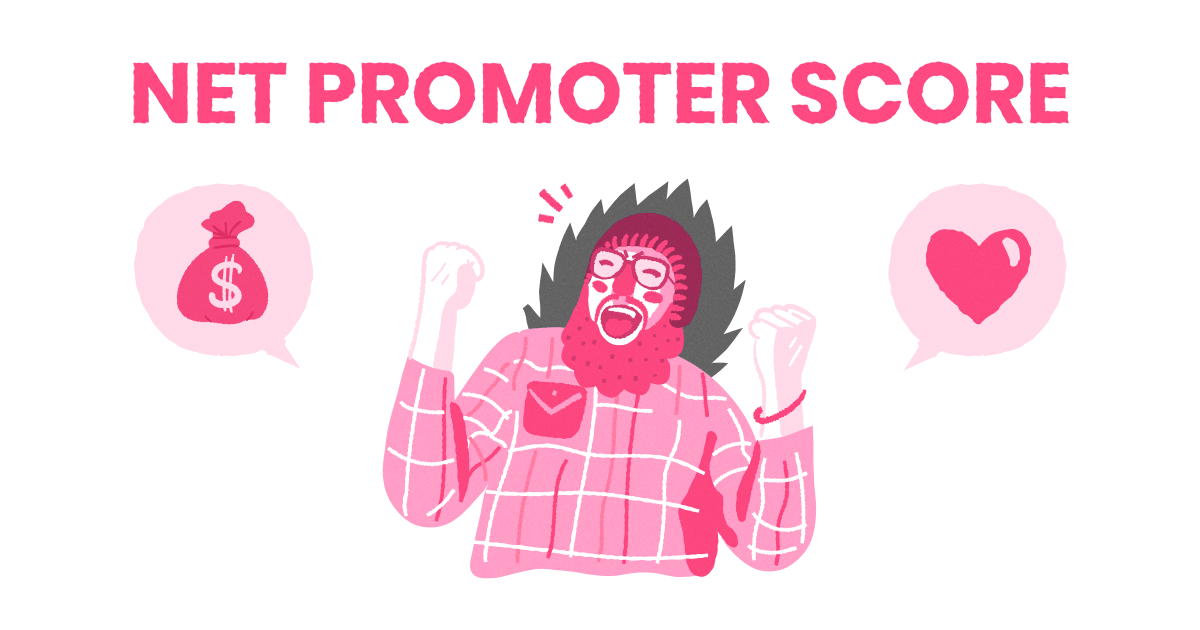“How likely are you to recommend us to a friend or colleague?”
As a customer, chances are you’ve heard these questions dozens of times. But did you know that this question isn’t only a measure of personal customer satisfaction?
A person’s likelihood to recommend a company plays into a much bigger metric: a company’s Net Promoter Score. NPS is a metric of a customer’s loyalty and satisfaction – and how likely they are to engage in promoting your brand, which will be essential for your business growth in the long term.
It’s the reason why NPS is our core product here at SatisMeter.
Create your SatisMeter account now
In this quick guide to the Net Promoter System, we’ll cover a few crucial questions:
- What an NPS is and why it’s important?
- How to calculate your NPS?
- How to collect data and track your NPS?
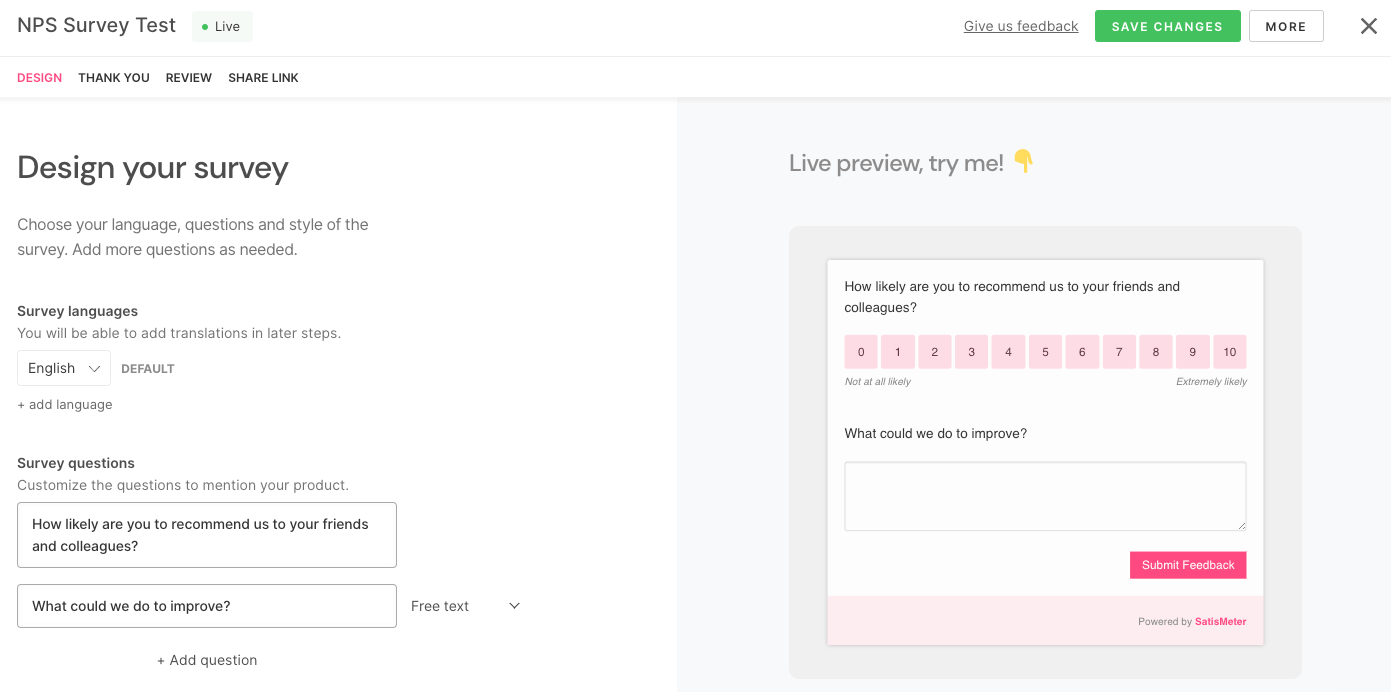
Design your first NPS Survey with SatisMeter
An Introduction to NPS (Net Promoter Scores)
Net Promoter Score, or NPS, is a measure that companies use to gauge customer loyalty to their brand. To start calculating this score, all you need is one single question:
“On a scale from 0 to 10, how likely are you to recommend us/our products or services to a friend or colleague?”
Collecting this data helps you to build an aggregate NPS score. In other words, you’re tracking a real-time measure of customer enthusiasm. By having a quantifiable metric to track your progress, you can find ways to improve your:
- Customer support
- Customer service
- Accessibility and delivery options
- Ease of use
Additionally, knowing your NPS score can help you better adhere to your mission. After all, without a defined and achievable mission, your business is going nowhere fast.
Of course, the end goal is to make sure all – or at least the majority – of your customers are satisfied. A satisfied customer is a loyal customer, and a dissatisfied customer is a potential loss of business.
Why is NPS So Important?
The danger of negative word of mouth
In the age of digital marketing, it’s easy to lose sight of the importance of word-of-mouth promotion. But just because most customer reviews now take place online doesn’t mean that IRL word-of-mouth is not a critical measure of your success, especially when it comes to negative word of mouth.
For example, did you know that an unhappy customer has a 91% chance of refusing to deal with your business again? Or that a dissatisfied customer may tell up to twenty other people not to do business with you?
Perhaps one of the most alarming statistics is that it takes 40 positive reviews to undo the damage wrought by a single negative post. That’s right. By cultivating a lousy relationship with a single customer, you have the potential to alienate up to twenty more (and that’s assuming they don’t post an online review either).
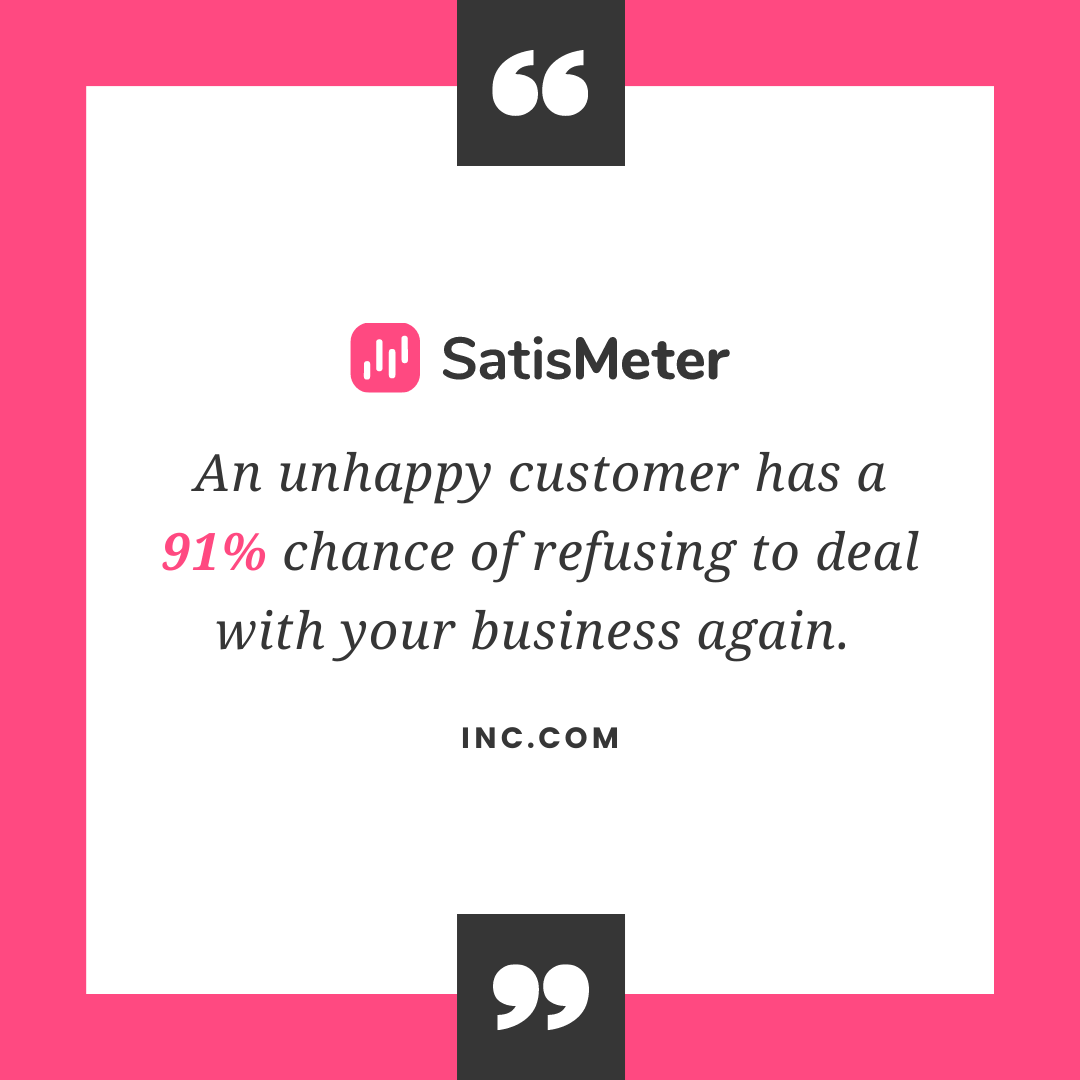
High and low NPS
These numbers reflect the importance of building positive customer relationships. But they also highlight how essential it is to keep track of your Net Promoter Score. While this score can indicate a number of metrics, it’s best to use it to predict customer happiness and business growth potential.
On the whole, a high NPS shows that your customers are satisfied with your company and products. And if you’re lucky, those happy customers will engage in positive brand promotion.
But a low NPS reflects a poor company culture or customer-business relationships. And, even if your unhappy customers aren’t taking to Yelp with their bad experiences, you can bet they’re telling their family and friends to avoid you at all costs.

Promoters, passive, and detractors are the three types of customers within your NPS
The Components of NPS
Before we talk about calculating your NPS, it’s crucial to understand the players. The Net Promoter System breaks down customers into three groups based on how likely they are to recommend your brand.
Promoters
Promoters are the customers who give you a 9 or 10 on the recommendation scale. This group is composed of your most loyal customers. They are also the group most likely to:
- Promote your brand (hence the name)
- Increase referrals and word-of-mouth business
- Generate additional growth for your company
Passives
Passives rate your business as a 7 or 8. While they aren’t likely to post negative reviews (or any reviews), they won’t go out of their way to promote you either. When you calculate your NPS score, you don’t include passives in your equation. But because they are so close to being promoters, you might want to spend some extra marketing dollars to win them over.
Detractors
Detractors are the consumers who give your business a rating of 6 or less. While not all detractors will harm your brand, most of them probably won’t patronize your company again. They’re also the most likely to post a negative review of their product or experience. And, as we saw above, negative reviews are much harder to overcome than positive ones.
Calculating your NPS: the formula
Now that we understand the three types of customers, we can calculate a Net Promoter Score.
To calculate your NPS, you first determine how many of them are detractors versus promoters in terms of the percentage of customers. Then, you subtract the percentage of detractors from the percentage of promoters.
And that’s all.
Unfortunately, calculating your Net Promoter Score is the easy part. The difficulty arises when interpreting your data.
Interpreting your Net Promoter Score
Since we’re working with percentages – i.e., numbers on a scale of 1 to 100 – it’s possible to see an NPS from -100 to +100.
If your business has a high number of detractors, you may end up with a negative number.
But if you’re doing well and have a high number of promoters, you’re more likely to see a positive score.
It is important to note that the average scores in the Net Promoter System vary by industry. You might not necessarily want to take your NPS at face value and try more to conduct some kind of NPS benchmarks. For example, if your industry’s average NPS is -50 and you’re sitting at a lukewarm +1, you’re still doing a lot better than your average competitor. (Although you should always be looking to improve your customer relationships!)
But if you come in at -100, whatever your industry average is, you’re doing badly on every level. This suggests that it’s time to take your customer relationships (or your product) up a notch.
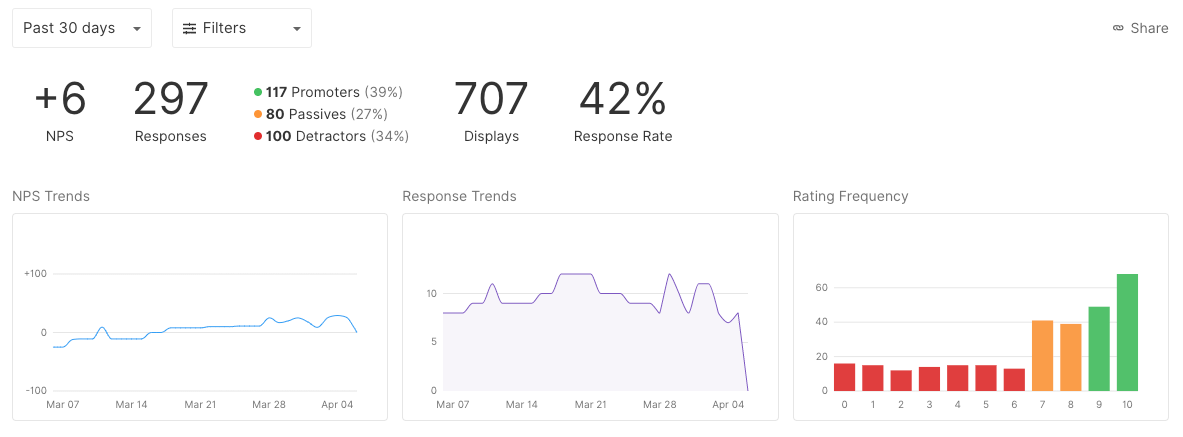
Interpret the results of your NPS within your SatisMeter results dashboard
What is a Good (and Bad) NPS?
Although Net Promoter Scores and data vary by industry, a low NPS still indicates that your business could do better.
So, where’s the cutoff for poor performance?
- On the whole, any score below 0 shows that most customers are very unhappy with your brand. If you fall between -100 and 0, it’s time to do some soul searching and discover where your weak points lie.
- Scores between 0 and 30, while not the best, are considered “good.” You still have a few unhappy customers, but for the most part, your business is heading toward success.
- An NPS between 30 and 70 indicates that most of your customers are happy. While there is still room for improvement, you’re chugging along in a comfortable lane.
Net Promoter Scores above 70 are the ideal to aim for – and, naturally, the hardest to achieve. This range shows that your business generates a lot of positive reviews from your customers. And the higher your NPS, the more likely your customers are to refer you to others. Over time, these word-of-mouth referrals will lead to increased conversions.
How to Collect Net Promoter System Feedback
We mentioned briefly the existence of a Net Promoter System as well as a Net Promoter Score. This is because the score is only one piece of the puzzle – the final outcome.
In the Net Promoter System, you collect feedback not just on your score but also on why customers rate your brand the way they do. This involves seeking feedback using unstructured, open-ended questions.
Your goal here is not to change how your customers view your company. Instead, you want to find out why they feel negative (or positive) feelings. Then, you can use this information to find ways to meet their standards and improve their customer journey.
If you want to start calculating and tracking your NPS – and the underlying cause – the first step is to run an NPS survey.
Typically, there are two ways to collect customer feedback: in the moment or after your customers have left the (metaphorical) building.
Of course, if you aren’t sure where to start, you can use a platform (such as SatisMeter) to get ahead. They help you customize your targeting, launch surveys, and set up triggers, so you can be sure you measure the customer experience the right way.
Web Surveys
When to use NPS web surveys?
Web surveys allow you to collect feedback before customers logged out from their personal space or closed their app. It gives them a chance to tell you what they think while their experience is still fresh.
You can set up web surveys in several places. The only thing is to make sure the survey is triggered only after your customer had a chance to fully experience your product or service. For instance, you may include one on your Thank You pages. Or you might set up a trigger so that a survey appears before your customers “X” out of your platform.
You may also want to include one at some point in the shopping experience, such as a “How Are We Doing?” survey.
How to use NPS web surveys?
Web NPS surveys should start off with the standard question: “On a scale of 0 to 10, how likely are you to recommend us/our product to a friend or colleague?”
Then, you can include a few other customized questions to seek more information about your customer experience. With SatisMeter new survey designer, you will have the opportunity to ask as many questions as you want and to change at ease their position in the survey. We are talking here about single-choice or open-ended questions that power up considerably the feedback of your customer:
- What is the reason for your rate?
- How can we improve your experience?
- Please select on this list of features the most important for you
Going further with conditional Thank You message
Based on how your customers answer your standard NPS question, it’s always a good thing to set up a conditional Thank You message that will allow you to adapt to the situation, whether your customer appears to be a promoter or a detractor.
If they select anything less than an 8, you might want to apologize for the negative feedback and ask additional open-ended questions like:
- Would it be okay for us to follow up on your responses?
- What is the best email address for our customer service team to reach you?
- Would you like to set up a meeting with one of our customer champions by clicking here?
Or, if your customers are happy with your service – a score of 9 or 10 – you might want to engage them to write you a review on a review website such as G2 or Capterra.
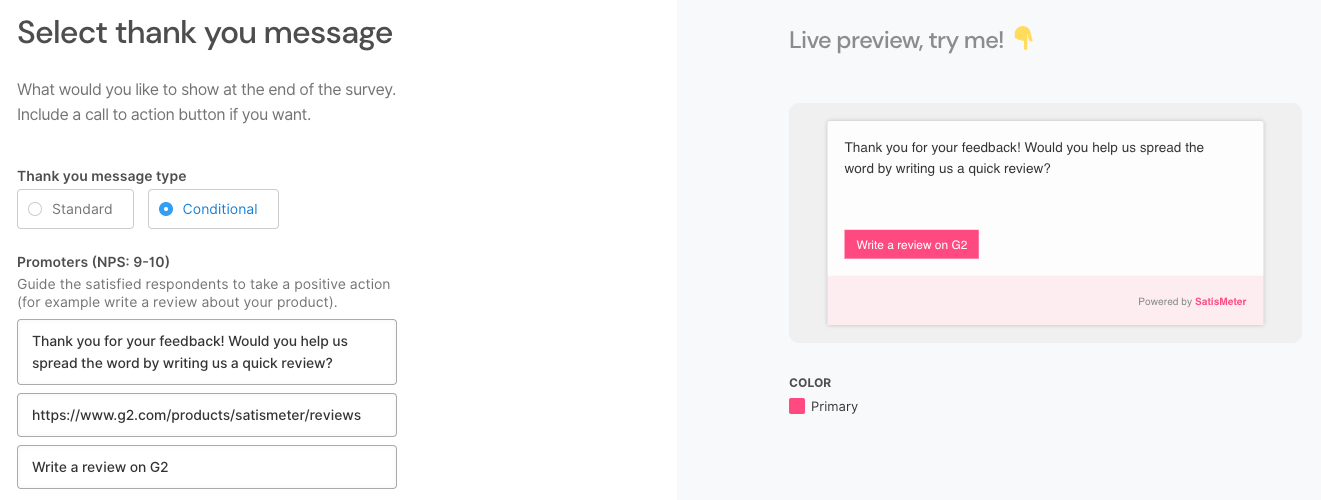
Set up a conditional Thank You message and a friendly call to action for your happy customers
To the infinite and beyond with email reminder
In order to improve the response rate, you can use SatisMeter to send email reminders directed to users who didn’t complete the in-app survey or the ones who didn’t log in to your app recently.
All you have to do is set up the number of days/weeks/months you would like to wait before sending out your reminder.
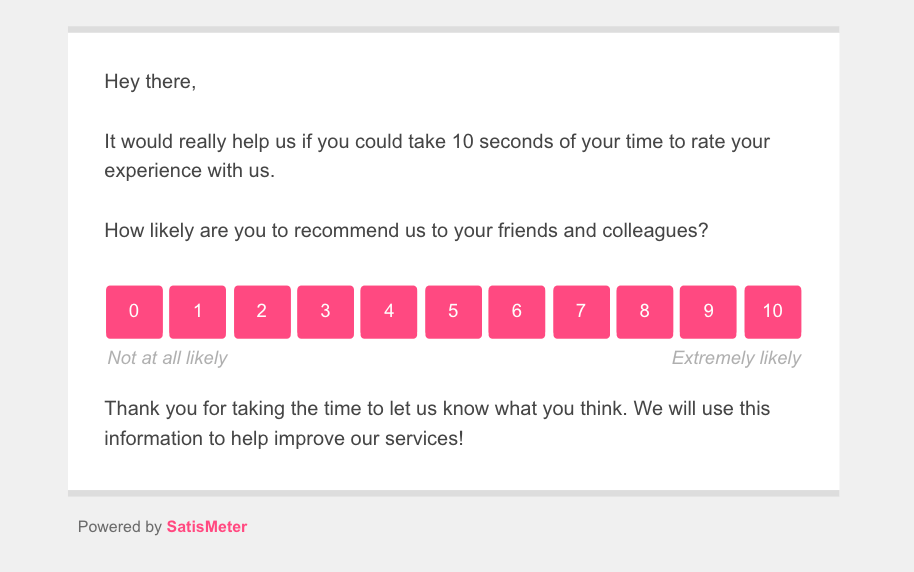
Send email reminder to follow-up on your NPS survey
A solid feature that leads us directly to the second type of NPS surveys, through email.
Email Surveys
When to use NPS email surveys?
Email surveys provide an alternative to an onsite survey. Instead of presenting people with a questionnaire before they leave the app, you can give them more time and send them a survey later on.
The benefit of email surveys is that they remove the pressure that onsite surveys put on your customers. Instead, they can take the survey at their own pace without feeling rushed. Plus, by giving your customers time to enjoy the product or consider their experience, they may gain clarity on whether they would recommend your brand to others.
How to use NPS email surveys?
Like web surveys, it’s better to trigger your email survey once your user had a chance to fully experience your product, and then to repeat the NPS regularly to monitor the evolution of your customer satisfaction.
For this reason, the NPS email survey design should be kept very simple and easy to read, with a direct NPS question and a short Thank You message.
SatisMeter will allow you to integrate with your favorite email provider (from Intercom to customer.io and Hubspot), which will give you the opportunity to see the results of your survey in your SatisMeter dashboard, along with other types of surveys.
Unlike web surveys, you can’t trigger automatically the display of your email survey, and you will have to set up manually your email provider with the template furnished by SatisMeter.
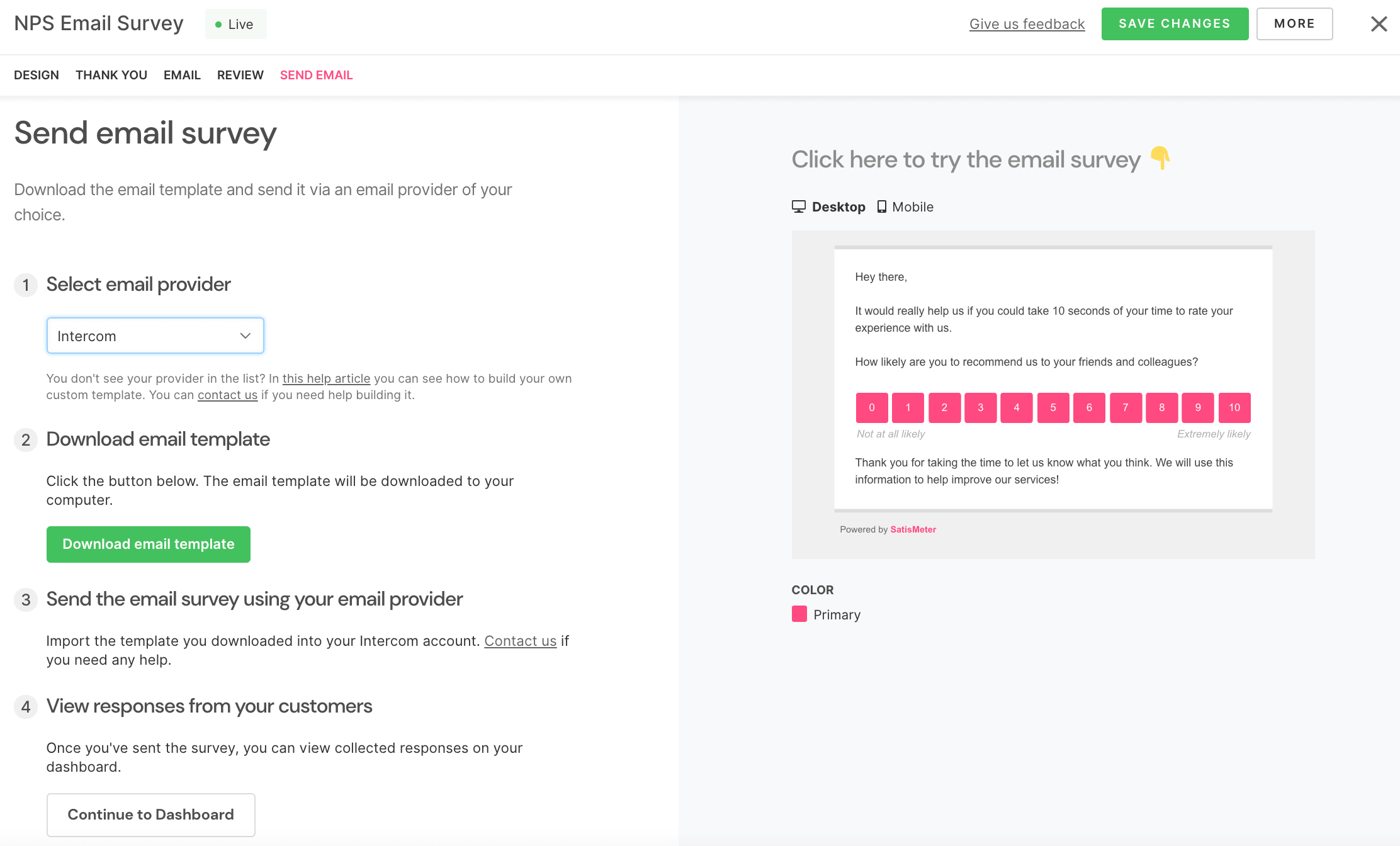
Check your template before sending your NPS email survey to your favorite email provider.
How to Read Your NPS Results?
We mentioned that NPS helps predict customer growth and satisfaction. But it’s also a great way to point out issues on the horizon at the individual and macro levels. That’s why it’s essential to learn how to translate your data into actionable results.
- The first thing to do is to divide your data into segments, such as age, gender, expenses, etc. Identifying unhappy customers can give you clues about specific segment issues.
- The second is to recognize that net promoter scores are not a stagnant metric. (If they were, that would suggest an inability to improve your business, ever.) Your scores can fluctuate every month, week, or even day.
Keeping up to date with how your scores are progressing can help you understand why your customers may be unhappy. This is why it is vital to keep records of your surveys and to continue sending them. Having NPS benchmarks of past performance allows you to compare your current actions to a relevant metric. And once you understand how your NPS changes over time, you can study the underlying factors.
- The third point in translating your data is to ensure that you have a reliable method for interpreting your score. Set up not only reliable metrics but also ways to follow up with your customers about their scores. (Another reason email surveys are so useful!)
By participating in field market research, you can solve individual problems much faster than filming in the dark. It will lead you to a more customer-centric approach – which in turn will lead to a higher NPS score.
Sign up now
